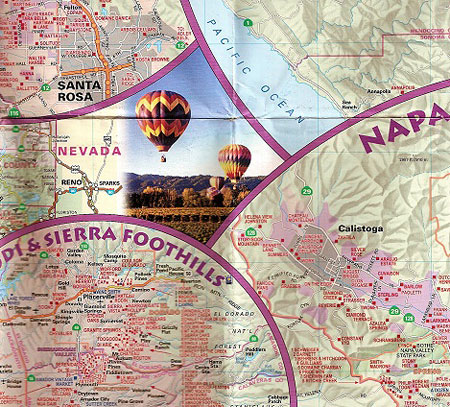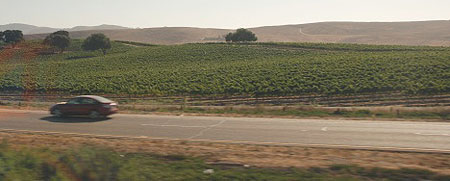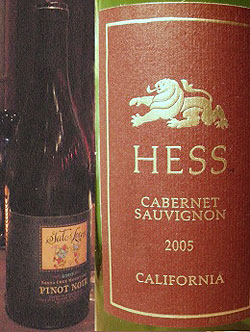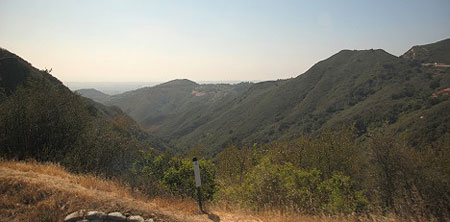One of the
most exciting coasts in the world, the west coast of California - along the Pacific Ocean - is opened up by a famous road, Highway No. 1. On the way from
Los Angeles to San Francisco, tourists' eyes are almost exclusively directed westwards along the 756-kilometre-long narrow road in order to catch as much of the coastal landscape as possible.
Whoever speaks of the "Californians" in our country probably thinks of the
Napa Valley and the cult wines produced there: "Opus One", "Screaming Eagle" "Harlan", "Maya", "Dalla Valle".... and all the others. Yet barely five percent of the wine produced in California is grown in this world-famous valley. Far more vines grow in neighbouring
Sonoma County. Hardly anyone in this country talks about the other four major wine regions in California. The North and
South Coast, for example, or - further south, almost on the Mexican border - Temecula. Even the designations of location and origin, which are so important here - they are particularly restrictive in the wine country
France as
AOC (
Appellation d'Origine Contrôlée) - tend to lead a shadowy existence in North America. Although there has been a wine classification here since 1980, the
AVA ("Approved Viticultural Area"), created on the
French model, it is far more liberal than almost any other state-checked designation of origin.

|
|
Excerpt from the California Wine Map% on which over 1000 wineries are marked.
|
This all reads informative, dry as dust and not at all column-like. In fact, I had to do my chores too. It wasn't just hours, it was days of looking up, reading up, researching, googling to expand on what I knew of wine California so far: shockingly little, shaped by the experience of our usual gastropub wines. Something like: "These are decent to good, cheap, but they always taste the same!". When I then stick my nose into the emptied glass, I am usually
met by a scent of jam, an unmistakable sign of concentrated wines "made" in the wine cellar. But in contrast to
French or even Italian cheap wines, I have even been
able to drink these Californians so far, to grant them a certain quality. "Well made, but boring!". The "other" Californians - the iconic ones - are hard to come by: the big names are too expensive for me or simply don't fit into my value system. So I conscientiously exclude them from my daily wine encounters. At best, they appear for me in advertisements or at horrendous prices at auctions.

|
|
Along the Pacific coast% the landscape is not always so friendly
|
But now I'm in California, on Highway Number One, driving along the "Central Coast" and looking in vain for vines. I can't blame my fellow travellers: they have no understanding for this, their attention is on the palm-fringed beaches, the deep canyons, the high granite rocks, the surf, the hairpin bends and the constantly changing landscapes. But I am looking for the wine region of the South and North Central Coast. I'm lucky in this respect: as the coastal road is only two lanes, flooded with tourists in their caravans and there are still more than 6,000 kilometres of road waiting for us, we quickly switch to Highway 101, the faster, well-built but boring route to San Francisco. Here - on both sides of the road - are many vineyards of the region. For the first time I see Californian vines, vineyards. And? Not much different from ours - only far larger, more extensive and more uniform.

|
|
Vineyards on the South Central Coast - kilometre-long fields
|
Hectares and hectares of new plantings, always the striking irrigation towers with the playful cogs and wings and - at this time of year - large, harvested fields, some of them in a neglected state.
After Santa Maria, I'm busy taking pictures non-stop. What is he clicking about in the world, mostly not even focusing on what there actually is to marvel at.....? There is a great danger that this column will now degenerate into a travelogue. I don't want that! I don't get to see the famous wineries, the expensive wines, the illustrious names. What I see, experience and capture in pictures is what a wine-interested tourist can see and experience on the endless route through four American states in the "wild west". And in terms of impressions, wine does not play a very important role. It is economically important, but in the consciousness of the population and the tourists it is rather a "marginal product". Hard to believe for us Europeans. In the huge area of "fast food", wine does not exist, and even in the "Hilton" of Los Angeles, the wine list is no more exciting or representative than the one in a smaller restaurant here with us. On the contrary: I have never drunk so much bad wine on a trip in hotels of the higher tourist class as in California.

|
|
An unfamiliar sight in our country - irrigation systems in the vineyards
|
After the bitter disappointment at the "Hilton" in LA, on my first evening in Santa Maria I finally wanted a Californian by the glass, a good mid-range wine. I even succeeded, for the first and only time for a long time.

|
|
Two "real" Californians - drunk in two different restaurants% in Sacramento (wine on the left) and Santa Maria (on the right)
|
It wasn't until Sacramento, in an Italian restaurant, that I managed to order a halfway "real" Californian for dinner again. In Santa Maria, it was a Cabernet Sauvignon from the Hess Collection Winery, which I had poured with a T-bone steak in a rather dark corner of a bizarrely decorated restaurant. Finally arrived in America. As conventional as it is: I love steaks and the Cabernet - probably available in the store for 20 dollars - was quite acceptable. After all, a Cabernet with character, a Californian character, and that is quite different from what I know from the Bordelais, for example. So I consumed the second quite good wine in an Italian restaurant. A wine with a rather bizarre name and an even more bizarre label. A Pinot Noir from Santa Cruz. I would never have ordered the wine, but the charming waiter insisted.
It was not a disappointment! A charming, or at least worthy of respect, representative of wine production in California, where almost 90 percent of American wines are made on about 13,000 hectares.
If you are now waiting for me to be "converted" in California and henceforth only stock Californians, I have to disappoint you. Even German echoes like Huber's Dornfelder from Santa Barbara County - which I unfortunately did not taste - cannot lure me onto the Californian highways of wine production.

|
|
Discovered in a Californian wine shop; Huber's Dornfelder from Santa Rita Hills.
|
"Highway Number One" remains an experience of untamed nature, not wine. Even the sunniest sandy beaches cannot hide the fact that the water in the Pacific barely reaches more than 17 degrees, even in the hottest period. I feel similarly about wine. Size and variety cannot hide the fact that only very rarely is the individuality achieved that I so appreciate in European wines.
I have raced through the regions on highways, rummaged through the stores and restaurants for names I recognise, and was finally pleased to be able to leave all the highways behind and now pour a "Californian" now and then here in Europe in all peace and quiet. Now, however, no longer distracted by the exoticism of the landscape and the legendary power fields on the Pacific coast.






